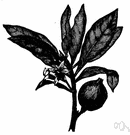genipap
Also found in: Thesaurus, Wikipedia.
Related to genipap: genipap fruit
gen·i·pap
(jĕn′ə-păp′)n.
1. A tropical American evergreen tree (Genipa americana) having yellowish-white flowers and edible fruits used in preserves or drinks. The fruits yield dark blue dye that is used as a body paint by Indians of tropical America.
2. The reddish-brown fruit of this plant. In both senses also called genip.
[Portuguese genipapo, from Tupí jenipapo, from yandi-ipab, genipap fruit.]
American Heritage® Dictionary of the English Language, Fifth Edition. Copyright © 2016 by Houghton Mifflin Harcourt Publishing Company. Published by Houghton Mifflin Harcourt Publishing Company. All rights reserved.
genipap
(ˈdʒɛnɪˌpæp) orgenip
n
1. (Plants) an evergreen Caribbean rubiaceous tree, Genipa americana, with reddish-brown edible orange-like fruits
2. (Plants) the fruit of this tree
[C17: from Portuguese genipapo, from Tupi]
Collins English Dictionary – Complete and Unabridged, 12th Edition 2014 © HarperCollins Publishers 1991, 1994, 1998, 2000, 2003, 2006, 2007, 2009, 2011, 2014
gen•i•pap
(ˈdʒɛn əˌpæp)n.
1. a tropical American tree, Genipa americana, of the madder family, bearing a round edible fruit.
2. the fruit itself.
[1605–15; < Portuguese genipapo < Tupi ianipaba]
Random House Kernerman Webster's College Dictionary, © 2010 K Dictionaries Ltd. Copyright 2005, 1997, 1991 by Random House, Inc. All rights reserved.
ThesaurusAntonymsRelated WordsSynonymsLegend:
Switch to new thesaurus
| Noun | 1. |  genipap - a succulent orange-sized tropical fruit with a thick rind genipap - a succulent orange-sized tropical fruit with a thick rindedible fruit - edible reproductive body of a seed plant especially one having sweet flesh Genipa Americana, genipap fruit, jagua, marmalade box - tree of the West Indies and northern South America bearing succulent edible orange-sized fruit |
Based on WordNet 3.0, Farlex clipart collection. © 2003-2012 Princeton University, Farlex Inc.